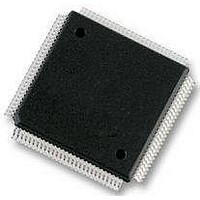MC912D60CCPVE Freescale Semiconductor, MC912D60CCPVE Datasheet - Page 380

MC912D60CCPVE
Manufacturer Part Number
MC912D60CCPVE
Description
IC MCU 16BIT 112-LQFP
Manufacturer
Freescale Semiconductor
Series
HC12r
Datasheet
1.MC912D60ACFUE8.pdf
(460 pages)
Specifications of MC912D60CCPVE
Core Processor
CPU12
Core Size
16-Bit
Speed
8MHz
Connectivity
CAN, MI Bus, SCI, SPI
Peripherals
POR, PWM, WDT
Number Of I /o
68
Program Memory Size
60KB (60K x 8)
Program Memory Type
FLASH
Eeprom Size
1K x 8
Ram Size
2K x 8
Voltage - Supply (vcc/vdd)
4.5 V ~ 5.5 V
Data Converters
A/D 16x8/10b
Oscillator Type
Internal
Operating Temperature
-40°C ~ 85°C
Package / Case
112-LQFP
Processor Series
HC912D
Core
HC12
Data Bus Width
16 bit
Data Ram Size
2 KB
Interface Type
CAN, SCI, SPI
Maximum Clock Frequency
8 MHz
Number Of Programmable I/os
86
Maximum Operating Temperature
+ 85 C
Mounting Style
SMD/SMT
3rd Party Development Tools
EWHCS12
Minimum Operating Temperature
- 40 C
On-chip Adc
10 bit, 8 Channel
Lead Free Status / RoHS Status
Lead free / RoHS Compliant
Available stocks
Company
Part Number
Manufacturer
Quantity
Price
Company:
Part Number:
MC912D60CCPVE
Manufacturer:
FREESCAL
Quantity:
203
Company:
Part Number:
MC912D60CCPVE
Manufacturer:
Freescale Semiconductor
Quantity:
10 000
- Current page: 380 of 460
- Download datasheet (5Mb)
Development Support
19.4.2 BDM Serial Interface
Technical Data
380
In special single-chip mode, background operation is enabled and active
immediately out of reset. This active case replaces the M68HC11 boot
function, and allows programming a system with blank memory.
While BDM is active, a set of BDM control registers are mapped to
addresses $FF00 to $FF06. The BDM control logic uses these registers
which can be read anytime by BDM logic, not user programs. Refer to
BDM Registers
Some on-chip peripherals have a BDM control bit which allows
suspending the peripheral function during BDM. For example, if the timer
control is enabled, the timer counter is stopped while in BDM. Once
normal program flow is continued, the timer counter is re-enabled to
simulate real-time operations.
The BDM serial interface requires the external controller to generate a
falling edge on the BKGD pin to indicate the start of each bit time. The
external controller provides this falling edge whether data is transmitted
or received.
BKGD is a pseudo-open-drain pin that can be driven either by an
external controller or by the MCU. Data is transferred MSB first at 16
BDMCLK cycles per bit (nominal speed). The interface times out if 512
BDMCLK cycles occur between falling edges from the host. The
hardware clears the command register when a time-out occurs.
The BKGD pin can receive a high or low level or transmit a high or low
level. The following diagrams show timing for each of these cases.
Interface timing is synchronous to MCU clocks but asynchronous to the
external host. The internal clock signal is shown for reference in counting
cycles.
Figure 19-1
BKGD pin of a target MC68HC912D60A MCU. The host is
asynchronous to the target so there is a 0-to-1 cycle delay from the host-
generated falling edge to where the target perceives the beginning of the
bit time. Ten target B cycles later, the target senses the bit level on the
BKGD pin. Typically the host actively drives the pseudo-open-drain
shows an external host transmitting a logic one or zero to the
Development Support
for detailed descriptions.
MC68HC912D60A — Rev. 3.1
Freescale Semiconductor
Related parts for MC912D60CCPVE
Image
Part Number
Description
Manufacturer
Datasheet
Request
R
Part Number:
Description:
Manufacturer:
Freescale Semiconductor, Inc
Datasheet:
Part Number:
Description:
Manufacturer:
Freescale Semiconductor, Inc
Datasheet:
Part Number:
Description:
Manufacturer:
Freescale Semiconductor, Inc
Datasheet:
Part Number:
Description:
Manufacturer:
Freescale Semiconductor, Inc
Datasheet:
Part Number:
Description:
Manufacturer:
Freescale Semiconductor, Inc
Datasheet:
Part Number:
Description:
Manufacturer:
Freescale Semiconductor, Inc
Datasheet:
Part Number:
Description:
Manufacturer:
Freescale Semiconductor, Inc
Datasheet:
Part Number:
Description:
Manufacturer:
Freescale Semiconductor, Inc
Datasheet:
Part Number:
Description:
Manufacturer:
Freescale Semiconductor, Inc
Datasheet:
Part Number:
Description:
Manufacturer:
Freescale Semiconductor, Inc
Datasheet:
Part Number:
Description:
Manufacturer:
Freescale Semiconductor, Inc
Datasheet:
Part Number:
Description:
Manufacturer:
Freescale Semiconductor, Inc
Datasheet:
Part Number:
Description:
Manufacturer:
Freescale Semiconductor, Inc
Datasheet:
Part Number:
Description:
Manufacturer:
Freescale Semiconductor, Inc
Datasheet:
Part Number:
Description:
Manufacturer:
Freescale Semiconductor, Inc
Datasheet:











